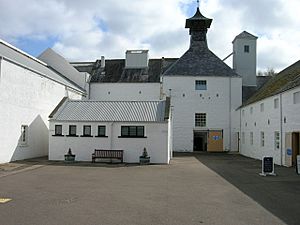Dallas Dhu distillery facts for kids
 |
|
| Region: Speyside | |
|---|---|
| Location | Forres, Moray, Scotland |
| Owner | Alexander Edward (1898) Wright & Greig Ltd. (1899–1918) |
| Founded | 1899 |
| Status | Museum since 1992 |
| Water source | Altyre Burn |
| No. of stills | 1 wash 6,300l , 1 spirit 5,600l |
| Dallas Dhu | |
| Type | Single malt |
| ABV | 40% – 43% |
The Dallas Dhu distillery is a special place in Forres, Scotland. It used to make a famous type of Scottish whisky called Speyside single malt. Today, it is a museum where visitors can learn all about how whisky was made. The name "Dallas Dhu" means "Black Water Valley" in the old Scottish language, Gaelic.
The distillery was first built in 1899 during a time when whisky making was very popular. It stopped making whisky in 1983. Since 1992, it has been open to the public as a museum. In July 2024, it was announced that the distillery would reopen under new management by Aceo Distillers Company.
Contents
A Look Back: The Distillery's Story
How Dallas Dhu Began
The Dallas Dhu distillery was first built in 1898. It was designed by a man named Alexander Edward. He called it "Dallasmore" at first. The distillery had a special roof shaped like a pagoda, which was a common design for distilleries in Scotland. In 1899, the distillery was sold to a company called Wright & Greig Ltd. They changed its name to "Dallas Dhu." The first batch of whisky was made on May 29, 1899.
Challenges and Changes Over Time
Over the years, the distillery faced many changes. In 1909, new rules were made about making whisky in the United Kingdom. These rules included higher taxes and a requirement that all whisky had to be aged for at least three years before it could be sold.
The distillery changed owners several times. In 1919, it was sold to J. P. O'Brian & Co. Then, in 1921, Benmore Distilleries Ltd. bought it. They added new equipment, like electric lights. In 1928, a larger company called Distillers Company (DCL) took over Benmore. Dallas Dhu then closed for a few years, reopening in 1936.
The Fire of 1939
On April 9, 1939, a big fire broke out at the distillery. Much of the equipment was damaged. The fire brigade from Forres arrived quickly and put out the fire in about four hours. The damage was quite costly. Because of the fire and the start of World War II, the distillery did not reopen until March 30, 1947.
Modernizing the Distillery
For a long time, steam engines and a large water wheel powered most of the equipment. But in the 1950s, the distillery switched to electric power. As more people wanted whisky, Dallas Dhu added new equipment in the 1960s. This included more large tanks for making whisky and a new boiler. The old stills were replaced between 1968 and 1969. In 1971, they changed from burning coal to using oil-fired steam to heat the stills.
The distillery used to make its own malt, which is a key ingredient in whisky. However, in 1968, a new malting plant was built nearby. This meant Dallas Dhu no longer needed to make its own malt.
From Distillery to Museum
In 1983, Dallas Dhu had to close down. This was due to economic problems and not having a reliable supply of water. The very last barrel of whisky was filled on March 16, 1983. The license to make whisky was officially taken away in 1992.
Even though it stopped making whisky, the buildings were reopened to the public in 1988. Since 1992, Historic Environment Scotland has managed the property. The distillery buildings are very important and are protected as a Category A listed building. This means they are considered buildings of special architectural or historic interest.
Visiting Dallas Dhu Today
Dallas Dhu is part of the Scotland's Malt Whisky Trail. This trail is a group of distilleries in the Speyside region that visitors can explore. The Speyside area is perfect for whisky making because it has good barley farms, the River Spey, and is close to a port.
At Dallas Dhu, visitors can walk around the grounds and learn about the history of Scotch whisky. You can explore the two-story malt barn, the kiln, and other original parts of the distillery. It's a great way to see how whisky was made in the past.

